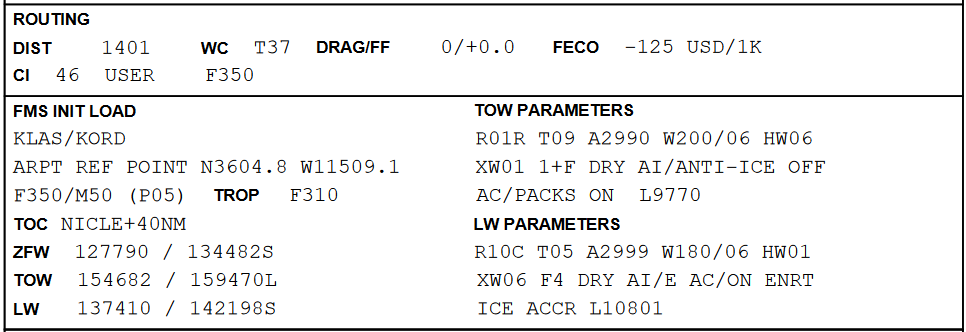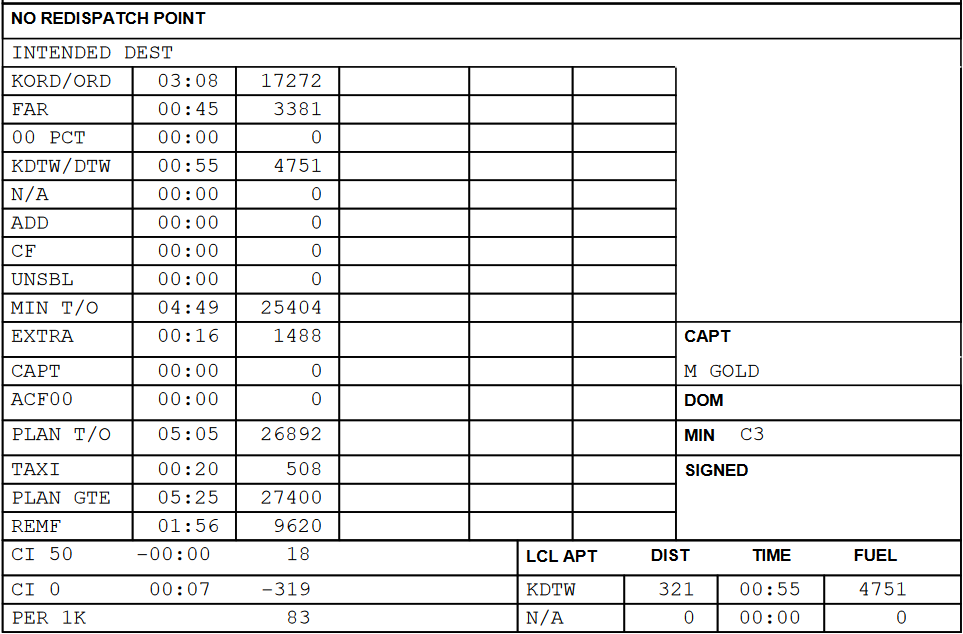Chapter 4: Operational Flight Plan (OFP) Format
Not intended for real world pilotage. For entertainment purposes only. Consult your manufacturer, operator, and/or local regulatory body for all operational requirements.
The default OFP format that vspirit uses for vAMSYS's Dispatch via SimBrief method is the UAL '18 format as the real Spirit format is not available and the UAL '18 OFP format is the closest to it. If an alternate OFP format is desired, selecting another OFP format is possible if the OFP is generated manually at SimBrief.
Some excerpts from this OFP follow, highlighting commonly sought information for FMS/FMC/MCDU initialization.

The header section on Page 1 of 4 of the OFP, approximately Page 9 of the briefing PDF, contains your Flight Number (NKS2524), your OOOI times, and the bottom line contains the time during which the wind predictions are valid. This is sometimes confused as wind direction/speed data. In this example OFP, the following section:
WIND 160000 161800
Means that the wind observations in the briefing are valid from 0000z to 1800z on the 16th day of the month

In the middle of the same page, you can find the ROUTING, FMS INIT LOAD, TOW PARAMETERS, and LW PARAMETERS sections. The highlights of this section are the Cost Index (CI), the Wind Component (WC), the planned ZFW, TOW, and LW, and some expected takeoff and landing parameters. The values of the most commonly sought variables in this example are:
Cost Index (CI) of 46
Wind Component of T37 (37 knot tailwind)
Zero Fuel Weight (ZFW) of 127,790 lbs.
Takeoff Weight (TOW) of 154,682 lbs.
Landing Weight (LW) of 137,410 lbs.
Cruise Flight Level of 35,000 ft.
Average cruise temperature of -50C (ISA Dev +05C)
Tropopause at 31,000 ft.
The TOW PARAMETERS and LW PARAMETERS sections offer information that may sometimes be helpful to you regarding conditions at your departure and destination airports, though you should primarily rely on METARS, ATIS, etc., as well as whatever performance tools you are using with your current add-on to verify anything to do with performance
R01R or R10C: The take-off and landing runways in this example.
T09 or T05: The forecasted temperature at the departure/arrival airport at the time of departure/arrival.
A2990 or A2999: The forecasted altimeter setting at the departure/arrival airport at the time of departure/arrival.
W200/06 or W180/06: The forecasted winds at the departure/arrival airport at the time of departure/arrival.
HW06/XW01 or HW01/XW06: The forecasted head/tailwind and crosswind components at the departure/arrival airport at the time of departure/arrival.
1+F or F4: Suggested take-off and landing flaps. This is a generic value provided by SimBrief; you may prefer to rely on the appropriate performance tool for your add-on.
DRY: Runway conditions at the departure/arrival airport at the time of departure/arrival. May also see WET or SLUSH.
AI/ANTI-ICE OFF, AI/E, etc.: Suggested anti-ice configuration.
AC/PACKS ON or AC/ON, etc.: Suggested pack configuration for performance.
ENRT ICE ACCR: Noting if ice accretion is expected enroute.
L9770 or L10801: The runway length of the previously identified runway at the departure/arrival airport at the time of departure/arrival.

The bottom half of the page outlines the planned fuel load, broken down into various components.
KORD/ORD 03:08 17272: This is the flight duration and required fuel load to fly to the planned destination, in this case Chicago O'Hare.
FAR 00:45 3381: This is the amount of fuel required by 14 CFR § 121.639; for domestic operations, it should always be at least 45 minutes. See Chapter 3 of the FOM for more information on fuel reserves.
00 PCT 00:00 0: This field appears to not be working as intended. It used to be connected to the "Contingency Fuel" field in the Fuel Planning section, but that value now seems to go into the "CF" line in this OFP format. This will be clarified later when possible.
KDTW/DTW 00:55 4751: This is the amount of fuel to reach the planned alternate, in this case Detroit, and it will require 55 minutes of air time and 4,751 lbs of fuel.
N/A, ADD, CF, UNSBL: Fields for various categories for extra fuel loads. CF, as mentioned above, currently displays any fuel in the Contingency Fuel box of the Fuel Planning section.
MIN T/O: This field shows the Minimum Takeoff Fuel amount. The vspirit checklist has a challenge and response below the line checking the required fuel amount and the fuel amount that is on board; this is the amount that is required in that checklist item.
EXTRA, CAPT, ACF00: More fields for various extra fuel loads. ACF00 is specific to the UAL format and stands for Analyzed Contingency Fuel.
PLAN T/O: This is the amount of fuel planned to be on board at takeoff and should be higher than the MIN/TO amount.
TAXI: This is the amount of fuel planned to be consumed during taxi out and taxi in.
PLAN GTE: This is the amount of fuel you are planned to push back from the gate with.
REMF: This is the amount of fuel planned to be on board when you park at the gate at the destination.
CI 50: This field shows the time saved/lost and additional fuel saved/burned if CI 50 is selected, compared to the planned cost index.
CI 0: This field shows the time saved/lost and additional fuel saved/burned if CI 0 is selected, compared to the planned cost index.
This page is under construction and will be added to in the future.